Category Archives: Farm Biz
Custom Spreadsheet Applications Are NOT Only for Accounting or Financial Reporting [Hint: Case Study of Tayo Solagbade’s Excel-VB Poultry Farm Manager – an Entreprise Information System]
The video screenshot below (click here to watch it) is of an Excel-VB spreadsheet software (called Poultry Farm Manager™) that I built – in 2014 – for a large poultry layer farm in Ekiti state, Southwest Nigeria, owned by a Nigerian diplomat, who was then based in a Francophone West African nation.
In 2009, I built the very first version of that app, for a 12,000 layer farm in Ogun State, also in South West Nigeria – owned by an entrepreneurial client couple.
Over they years, I’ve gotten lots of attention for this singular app, confirming my gut level instinct that smallholder Farm CEOs across the world are generally neglected in terms of their data handling and report generation for timely/accurate decision making needs.
But – contrary to assumptions made by some of the farm business owners who come to me, this Poultry Farm Manager app is NOT an accounting application.
Yes, it does income and expense recording and reports weekly, monthly and annually as indicated in the video.
However its main purpose is to record daily operations data so as to auto-generate Key Performance Indicators (KPIs) for determining how well the animals are doing on a DAILY basis.
As data is punched in, the automated charts are instantly plotted for KPIs like feeding rates, Hen Day Percentage, Mortality Rate; Feed to Egg Conversion Ratio.
The trend of the charted data quickly tells you if there’s anything to worry about. And you can then take corrective action.
I call my applications of this kind “Enterprise Information Systems” (EIS).
This Poultry Farm Manager spreadsheet application originally catered for poultry layers farm operations…
But following inquiries/requests from Farm CEOs reaching out to me from within and outside Africa; I have since included an interface that handles data entry and report generation for a broiler operation.
This includes auto-generation of feeding rate, feed to flesh conversion ratio, mortality rate, growth rate etc, on a daily, weekly, monthly and annual basis.
Those are the KPIs it measures.
What custom spreadsheet software solution or “Enterprise Information Systems” (EIS) do YOU need?
I have a vision to help small holder farmers (and other businesses) adopt intelligent and cost-effective custom software solutions to manage their farm business more profitably for the long term.
This is why I’m being deliberate in finding the RIGHT clients to work with. It’s NOT a matter of how much money you’re willing to pay, but how committed you will be to making use of the solution developed to solve a real life problem you have, in a way that it can be used to help others.
If the above describes YOU, fill and submit the form on the page linked here (click).
Potential Spreadsheet Automation Benefits that Farm Businesses Need to Succeed Better [Hint: Insights from Agribusiness Research Survey Interview of Farm Industry Stakeholders]
This article features – and discusses (with charts) – responses to questions in an agribusiness research survey questionnaire I circulated a few years ago.
The semi-structured questionnaire was used to solicit responses from farm owners, feed makers and extension experts. Some were buyers/users of my Excel-VB Ration Formulator™.
CEOs of smallholder (fish, pig, and poultry) farm businesses make up 80% of respondents (30% of them own feed mills, to control feed cost/quality), and 20% are farm support specialists.
22.2% of those who formulate their rations use the Excel-VB driven Ration Formulator™. Others use off-the-shelf software (11.1%), manual Excel workbooks (11.1%), and calculators (11.1%).
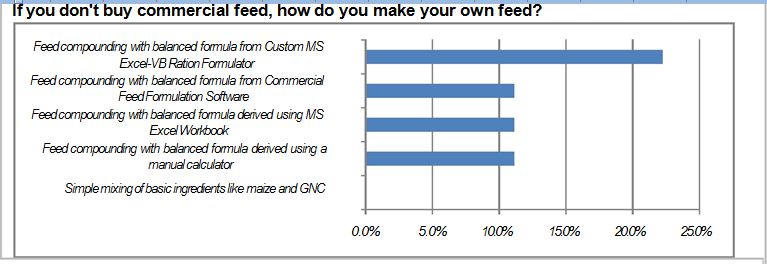
Over 75% of the respondents were 41 years old and above. At least 55.6% hold a University Masters degree; one is a PhD holder, and some also hold professional qualifications.

Not surprisingly, all 55.6% say they always aim for least cost feed formulation. This suggests they are likely to adopt customizable Excel apps that quickly and accurately formulate rations.

Those who own feed mills will thus confidently formulate useful rations for themselves, and other farmers who come to their mills. Multiple benefits will thus accrue to the industry.
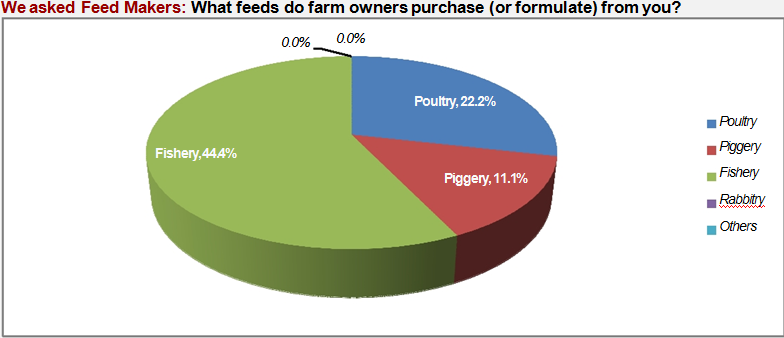
55.6% buy commercial feed (from “2 sources” or “anywhere they can find”). 66.7% of that percentage says they their animals’ performances vary noticeably with different sources of feed.

Their farm output tends to fluctuate as a result – and that naturally bothers the farmers.
Hen Day Percentage (HDP) data auto-charted – in September 2013 – by a custom Excel-VB software built for a layers farm in South West Nigeria, appears to support the above.
When the two farm managers were asked about a sharp downward slope of charted HDP data, over a one week period (from above 70% to between 55 and 65%), their checks revealed it coincided with their use – due to cash flow problems – of feed from a different supplier!
Customizable Excel-VB driven tools can help such farmers consistently formulate their own feed to specification. More predictable livestock performance and reduced feeding expenses will occur, and ultimately lead to increased profits.
Read: One New Skill Modern Extension Professionals Need to Succeed
5 Proven Smart Spreadsheet Automation Benefits to Any Business [Hint: Comparing a Manual Excel based Feed Formulation Spreadsheet with an Excel-VB Driven Ration Formulator Spreadsheet Application]
Various farm support experts already offer different Excel based feed formulation tools for farmers.
Some itemize steps users can follow, to manually create formulas in MS Excel worksheets, to build simple feed formulation tables. When the user gets it right, this works okay.
But such solutions can sometimes be like asking users to work in a minefield
When a controlled environment is lacking, the target audience can make all sorts of mistakes. The damage from feeding animals wrong ration formulas can be devastating, and sometimes irreversible!
Apart from errors, manual Excel feed formulations workbooks can be cumbersome, time consuming, and tiring to use. Farmers with pressing farm concerns rarely find them endearing!
That’s why I believe the ease of use, time saving – and accuracy/reliability – of manual Excel- solutions, will be greatly enhanced if they are modeled after the Excel-VB Ration Formulator™.
One Example: A Windows-Based User-Friendly Feed Formulation Workbook (WUFFDA) for Rabbits is available online.
It uses a range of ingredients and nutrient profiles, including amino acids, and trace minerals.
However, it needs manual updating of different large data tables periodically. Users have to copy and paste across tables, highlight/drag ranges of cells, scroll through large sheets etc
When using MS Excel, that is an invitation to user generated errors of all kinds!8,9,13
The WUFFDA is a great feed formulation resource. However, intelligent Excel-VB automation, with intuitive graphic user interfaces, will make it more user-friendly (by simplifying and/or taking over routine and repetitive tasks), while also making it more reliable and accurate.
Typical benefits of using the above approach include (See examples in the case study featured in Issue 052 of my Performance Improvement Ideas (PII) newsletter published 2 days ago – click here):
i. Reduction of User Created Errors: Error handlers can be built-in to prevent users from accidentally ending up with faulty rations for an example).
ii. Time and Effort Saving User Friendliness: in-cell drop down menus, as well as automated floating data entry forms, with drop menus speed up data entry by reduce typing.
iii. Feed Formulation Speed and Accuracy: Excel’s powerful calculation engine, combined
with useful database functions, and Excel-VB automation, will enable fast generation of multiple ration formulas, with minimal effort. Since the process is automated, repeat accuracy is assured.
iv. Adaptability: Best practice worksheet design, and customizable interfaces/code make it easy for a competent person (e.g Excel-VB trained extension specialist) to modify the app to
suit changing requirements, whenever the need arises: with no developer fees incurred!
v. Extension to Other Farm Business Aspects: Learning achieved can be easily applied to17
other farm business aspects e.g tracking poultry layers’ Key Pe4rformance Indicators(KPIs)
using an Excel-VB Poultry Farm Manager™ (See 16 Step-by-Step Screenshot User Guide Video Tutorials for it here – click).
NB: This article is based on excerpts from this 2013 international agribusiness paper.
PII 052: Real Life Farm Business Case Study – Excel-VB Ration Formulator Spreadsheet Software Anatomy
In this week’s issue of my Performance Improvement Ideas (PII) newsletter, I discuss – using annotated screenshot images – design considerations employed in developing my popular Excel-VB Ration Formulator spreadsheet software.
Prospective buyers, as well as users/owners of this app curious to better understand how it works, and how to make more productive use of it, will find reading this a useful experience – as would persons interested in learning how to build commercial quality apps with user friendly features.
This is a real life farm business case study designed to offer potentially useful insights other business users can learn from, in building zero cost custom apps to solve real life problems.
SCROLL DOWN TO READ FULL ISSUE
|
|
|
Tayo K. Solagbade* Self-Development/Performance Improvement Specialist *Best Practice Farm Business Support Specialist & Founder of the MS Excel Heaven Visual Basic Automation Club and Competition Mobile: +234-803-302-1263 (in Nigeria) or +229-66-122-136 (in Benin Republic) Tayo K. Solagbade is a Location Independent Performance Improvement Specialist and Multipreneur (i.e. a highly versatile/multi-skilled entrepreneur), with a bias for delivering Best Practice solutions to Farm Businesses and others. Since 2002, he has earned multiple streams of income providing individuals and organizations with personal development training and coaching, custom MS Excel-VB solutions, web marketing systems/web hosting, freelance writing services, and best practice extension support services (for farm business owners). Tayo is the author of the Self-Development (SD) Bible™ and the popular Livestock Feed Formulation Handbook. He is also the developer of its accompanying Excel-VB driven Ration Formulator™ and the Poultry Farm Manager™ software. He has delivered talks/papers to audiences in various groups and organizations, including the Centre for Management Development, University of Lagos, Christ Baptist Church, Volunteer Corps, Tantalisers Fast Foods and others. In May 2012 he was the Guest Speaker at the Centre for Entrepreneurship Development’s Annual Semester Entrepreneurial Lecture at Yaba College of Technology in Lagos. On 1st April 2013, Tayo (who reads, write and speaks the French language) relocated to Cotonou, Benin Republic to begin slowly traveling across the West African region. His key purpose is to deliver talks, seminars and workshops on his key areas of focus and interest to interested audiences (Email tayo at tksola dot com for details). In a previous life, before leaving to become self-employed, Tayo served for seven years (October 1994 to December 2001) as a high performing manager in Guinness Nigeria. He rose from Shift Brewer to Training & Technical Development Manager, and later acted in senior roles as Production Manager and Technical Manager. In addition to constantly challenging the status quo and influencing positive work changes, he built a reputation for using self-taught spreadsheet programming skills (starting with Lotus 1-2-3, and later moving to Excel Visual Basic) – in his spare time – to develop Automated Spreadsheet Applications to computerize manual report generation processes in the departments he worked. Over four(4) of his applications were adopted for brewery level reporting. Tayo holds a B.Sc degree in Agricultural Extension Services from the University of Ibadan, Nigeria, having graduated top of his class – with Second Class Upper Division honors – in 1992. He is an Associate Member of the UK Institute & Guild of Brewing, a 1997 National Finalist of the Nigerian Institute of Management’s(NIM) Young Managers’ competition, a Certified Psychometric Test Administrator for Psytech UK, innovator of Spontaneous Coaching for Self-Development™ (SCfS-D™), and Founder of the Self-Development Academy (SDAc). When he’s not amazing clients with his superhuman skills (wink), Tayo works as the creative force behind his Daily Self-Development Nuggets blog – on which he also publishes The Farm CEO Weekly Newspaper (sent via email to paid subscribers) and his Weekly Performance Improvement IDEAS newsletter. You can connect with him on Twitter @tksola.com and Facebook. Visit Tayo Solagbade Dot Com, to download over over 10 performance improvement resources to boost your personal and work related productivity. ====
|
The FARM CEO (Issue 72) : One New Skill Modern Extension Professionals Need to Succeed, The Need to Explore Cheaper Local Alternative Feed Ingredients In Formulating Least Cost Diets, Two (2) Feed Formulation Compounding Problems Farm CEOs Need Extension Specialists to Help Them Solve
In this week’s issue of the Farm CEO newspaper, I feature 3 articles discussing possible ways Extension solutions can evolve to better meet the needs of farm businesses. Especially in the area of data recording, analysis and report generation automation, towards achieving timely and cost-saving decision making.
1. Two (2) Feed Formulation Compounding Problems Farm CEOs Need Extension Specialists to Help Them Solve
In this article, I discuss two major challenges that many farm CEOs face that tend to limit their ability to deliver a consistent quality of balanced feed to their livestock – especially in Nigeria/Africa. 1. Poor Feed Compounding Know-How Apart […]
2. One New Skill Modern Extension Professionals Need to Succeed
Findings from a 2013 questionnaire survey I conducted of Farm CEOs in Nigeria, for an international agribusiness paper I was engaged to write revealed 55.6% bought commercial feed (from “2 sources” or “anywhere they can find”). 66.7% of that percentage said their animals’ performances varied noticeably with different sources of feed. Their farm output tended […]
3. The Need to Explore Cheaper Local Alternative Feed Ingredients In Formulating Least Cost Diets
Rising prices of major feed ingredients like Maize, Fish Meal and Soya beans plus dangers associated with aflatoxin complications in use of groundnut cake, have driven many farm business owners to explore alternative feed ingredients. But in doing so, they also have to enter uncharted territory. Locally available ingredients which are often cheaper, typically tend […]
[Recommended] 16 Essential Terms You Must Know To Learn VBA Programming
This week I refer members of my Excel Heaven Visual Basic Automation Club to an excellent article (by By Jorge A. Gomez) that discusses key VBA programming terms that one needs to understand, in order to succeed in developing useful VBA applications.
Like I continue to emphasize to my club members, I believe in exposing those learning from me (via the home study tutorials I send them) to the work of as many other competent experts as I can find, so they get the benefit of insights from a wide variety of perspectives.
This, in my experience will boost their abilities to develop flexibility in their creativity, when developing their own unique solutions for clients.
My success in developing a unique range of custom Excel-VB software that I sell for passive income, to buyers within and outside Africa derives from my own exposure to similar influences.
Excel VBA Tutorial For Beginners: 16 Essential Terms You Must Know To Learn VBA Programming
So you’ve created your first (or your first few) Excel macro(s), perhaps by following these 7 easy steps to create a macro. By now, your colleagues are already looking at you like you’re a wizard.That is a great sign that you’re on a good way to learning macros and Visual Basic for Applications (VBA).
However…
Being able to create a basic macro in Excel is only the beginning in the process to become a really efficient and productive user of macros and VBA. If you really want to unleash the power of these tools, you must learn VBA due to the fact that, among others, recording a macro sometimes simply doesn’t “cut it”.
https://powerspreadsheets.com/excel-vba-tutorial-essential-terms/
Two (2) Feed Formulation Compounding Problems Farm CEOs Need Extension Specialists to Help Them Solve
In this article, I discuss two major challenges that many farm CEOs face that tend to limit their ability to deliver a consistent quality of balanced feed to their livestock – especially in Nigeria/Africa.
1. Poor Feed Compounding Know-How
Apart from knowing the ingredients’ nutrient compositions in order to formulate rations, there is also the often ignored aspect of proper feed compounding i.e. milling/grinding and mixing of the physical feed ingredients for the animals to eat (using the derived formula as a guide).
If feed compounding is not well done, a derived ration formula will yield little or no useful value!
Alternative ingredients like Sorghum, from trials done by researchers, and feedback from farmers who use it, show that it needs to be milled to a certain consistency, if it is to be well utilized by animals fed a ration in which it replaces maize.
Some farmers are not familiar with best practice feed compounding. A good ration formula, poorly compounded, gives poor results! Compounded feed with poor palatability and/or digestibility will be poorly consumed or utilized- and the animals will not perform well.
Extension specialists must verify that farmers understand the importance of proper feed compounding. Those identified to lack it must be given needed “education” – and/or encouraged to compound rations at a feed mill where required best practices are observed.
2. Lack of Adequate/Accurate Nutrient Composition Data for Feed Ingredients
The farmer must also know what his animal’s nutrient requirement is, at different stages of growth and production (See figure 3 in Annex 1.0).That’s why laboratory analysis of ingredients (and compounded feed) must be periodically done.
In Nigeria, farmers lack ready access to laboratory facilities. So many use data from published sources – mostly foreign. But that’s best used only as a temporary guide. Chemical composition of food grown locally in Nigeria differs considerably from those in tem5perate climes – due to complex interactions of factors like soil, species, strains, climate etc.
But Nigerian farmers contend with unusual additional costs e.g. most generate up to 80% of their power supply, and even drill boreholes to supply safe water for their animals.
That can often be a disincentive to sending feed/ingredients samples for laboratory analysis.
Standard feed composition tables, featuring locally available feeding stuffs can greatly mitigate these challenges, making farmers more willing to use software formulation.
Extension specialists can collaborate with relevant others to make those tables available. Locally available ingredients that can replace expensive/less available ones must be included.
A useful foundation on which to build has been provided by some workers.
Extension specialists can incorporate tables they compile, into their custom Excel-VB software. Farmers would then use a few mouse clicks to choose feed ingredients using drop menus in any combinations they want, to formulate least cost rations (e.g see screenshot from my Excel-VB Ration Formulator software below).
This article is based on excerpts from the international agribusiness paper in which I advocate adoption of Excel-VB solutions development by Extension professionals, to support farm businesses with their data handling, analysis and report generation needs.
One New Skill Modern Extension Professionals Need to Succeed
Findings from a 2013 questionnaire survey I conducted of Farm CEOs in Nigeria, for an international agribusiness paper I was engaged to write revealed 55.6% bought commercial feed (from “2 sources” or “anywhere they can find”).
66.7% of that percentage said their animals’ performances varied noticeably with different sources of feed.
Their farm output tended to fluctuate as a result – and that naturally bothered the CEOs.
Hen Day Percentage (HDP) data auto-charted – in September 2013 – using my Excel- VB Poultry Farm Manager software on a layers farm in South West Nigeria suggested the trend noticed from the survey was accurate.
When the two farm managers were asked about a sharp downward slope of charted HDP data, over a one week period (from above 70% to between 55 and 65%), their checks revealed it coincided with their use – due to cash flow problems – of feed from a different supplier!
Customizable Excel-VB driven tools can help such farmers consistently formulate their own feed to specification.
More predictable livestock performance and reduced feeding expenses will occur, and ultimately lead to increased profits. See study’s full survey results in the PDF paper – click here to learn how you can get a FREE copy.
Excel-savvy extension workers can be selected to attend practical Excel-VB training – with deliberate focus on real-life farm solutions development.
It’s not likely that farm CEOs will be able to find the time to learn MS Excel Automation – even though it’s obvious that they readily embrace the flexible, and affordable Excel based solutions that can be had.
This is why I have continued to argue through my writing on Best Practice Farm Business Management, that Extension Professionals will be best placed to deliver the customizable low cost data handling and report generation solutions to farm businesses using MS Excel VBA.
In the agribusiness paper on this subject, I made the following suggestions about what extension workers need to do, to develop this valuable competence, so they can become better able to help Farm CEOs:
1. Each must have sound understanding of feed formulation science
2. Classes and useful text for self-study should be provided for those lacking – and their competence verified.
3. Next, they either learn Excel-VB programming – or engage someone who does. If the latter, we recommend they still learn some Excel-VB, so they can modify the software in future.
4. Step-by-step instructions (with annotated screenshots) should be provided for farmer-users.
5. Tools: PCs, preferably laptops, since battery power makes work possible in absence of continuous power. In Nigeria, where power supply is unreliable, this is important. A farmer may not initially be keen to put on his/her generator, just to see new feed formulation software!
6. Solutions developed must be adapted to suit MS Excel versions on farmers’ PCs. One client refused to replace his Excel 2003 with 2010 version because it looked so different. My Ration Formulator™ is built to be compatible with old and new/future MS Excel versions.
7. Encourage Farmers to Develop Indigenous Knowledge Systems: Years of supporting farm CEOs has revealed one fact: Smallholder farmers are keen to collaborate with “developers” of low cost “easy-to-use” software that can help them.
A phone conversation I had with a Canada based Farm Project Manager – Ronald V. – on 14th November 2013 is instructive with regard to the last point mentioned above.
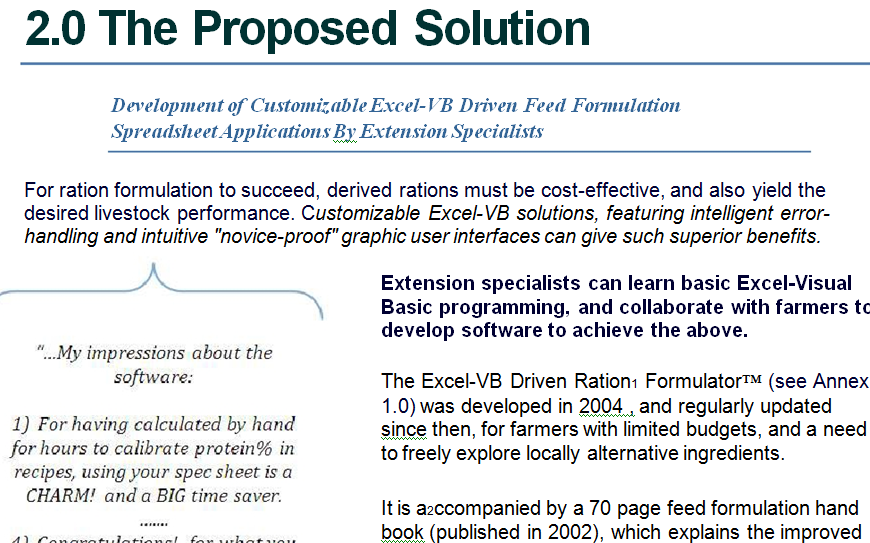
He’d bought my Ration Formulator via Paypal (sent to my brother-in-law in the UK) some weeks earlier. Findings from a USA university’s study had led him to adopt peas usage in rations fed to pigs that made replacement of Soya bean possible, with no apparent negative impact on performance.
His nutritionist had advised using Soya beans in a feed formulation application built for pigs. But the need to reduce variable costs drove him to test the university’s model. He replaced the data for Soya beans he’d posted in my app, with that for peas. Months after, he was still getting good results!
He ended the call by suggesting my Excel-VB app featured be modified to cater for pigs as well (with regard to their elaborate amino acids balancing needs).
That “suggestion” from him, is a good example of how farm business solutions can evolve based on user feedback for a while, before their features can be considered adequate for most possible scenarios.
My interactions with another farm CEO, this time in Africa, provides another useful illustration:
In Nigeria, an Ibadan, Oyo State – Nigeria based catfish farm owner I spoke with on phone, in the course of gathering information for my paper, explained that he regularly explores use of alternative ingredients.
After careful laboratory analyses, he hads found a way to use noodles waste, and cassava flour (known locally as “Gari”) up to 40% in formulated rations, to reduce the farm’s feeding costs.
According to him, the performance of his fish had not suffered.
Summary: Extension specialists can develop cost-effective customizable Excel-VB solutions to help farmers tackle pressing challenges they face
Discoveries that occur in the process – like those mentioned in the anecdotes narrated above – when shared, can convince other farmers to also adopt the superior Excel solutions.
That’s one of the ways my featured Excel-VB driven Ration Formulator™, and its Excel-VB Poultry Farm Manager™ sibling have been successfully introduced and sold, to Farm CEOs within and outside Africa, over the years.
It is my considered opinion that other extension professionals can do what I’m doing – and the farm business industries we serve, will be better off in the long run!
Related Article: Story: After Resolving Layers Feeding Problems, Selling Increased Eggs Output Became a Headache!
The Need to Explore Cheaper Local Alternative Feed Ingredients In Formulating Least Cost Diets
Rising prices of major feed ingredients like Maize, Fish Meal and Soya beans plus dangers associated with aflatoxin complications in use of groundnut cake, have driven many farm business owners to explore alternative feed ingredients.
But in doing so, they also have to enter uncharted territory. Locally available ingredients which are often cheaper, typically tend to be less well documented in terms of their value to animals . Farmers often have to settle for “typical values” from published reports, or send samples to the laboratory.
Different feed formulation methods exist, such as linear programming, Pearson square, and stochastic programming.
The farmer’s choice of method must be guided by the purpose of the diet s/he aims to formulate. For instance, catfish and poultry have amino acid needs that vary greatly from that of pigs.
The farmer will have to take that into account in formulating his/her rations. But that can be a tasking process!
Low Cost Automated Feed Formulation is Needed
Software automation can make that process less tasking, and more reliable in terms of accuracy.
But feed formulation software tend to be pricey (See email excerpt).
In addition, some – due to legal requirements – limit ingredients types usable (see sidebar) .
That’s why more farmers now adopt manual Excel forms developed by researchers/extension specialists.
The Threat of Avoidable Feed Formulation Errors
But using MS Excel manually for a serious (and sensitive) task like feed formulation requires sound Excel user skills .
Unfortunately, many users often assume they know enough. That mental attitude sometimes lead to avoidable errors, that are hard to detect – with potentially costly consequences in the case of a farm business.
One Example:
A client’s secretary placed a file on the PC keyboard, to answer the phone. A formula cell in the spreadsheet she was working on got overwritten in the process, with a value that coincidentally looked real.
The error went unnoticed until the next week, when her boss asked why the new total was exactly the same, despite a totally different expense profile. This can happen to a farm based user too!
Rejuvenation of smallholder farming in developing economies depends greatly on empowering all stakeholders.
This will involve helping them entrench continuous improvement and best practice systems based primarily on indigenous knowledge systems they discover, and successfully implement.
Firm management of expenses is crucial to profit making in any business – including farming. For livestock farmers, feeding expenses constitute the greatest concern.
That’s why working towards least cost ration formulation, by exploring low cost alternative ingredients, is critical. It cannot be done haphazardly – otherwise, costly mistakes could result.
PC based automation can be used to cost-effectively derive accurate ration formulas.
Laudable efforts have been made by extension specialists, to develop flexible MS Excel based feed formulation resources for farmers.
It must however be noted that farmers need more time/effort saving, and robust error-resistant solutions, to derive ration formulas that yield profitable performance.
The customizable Excel-VB driven Ration Formulator™ (that I sell along with my popular Feed Formulation Handbook) is presented as an example of what is possible in the International Agribusiness paper I got paid to write in 2013 – from which THIS article was excerpted.

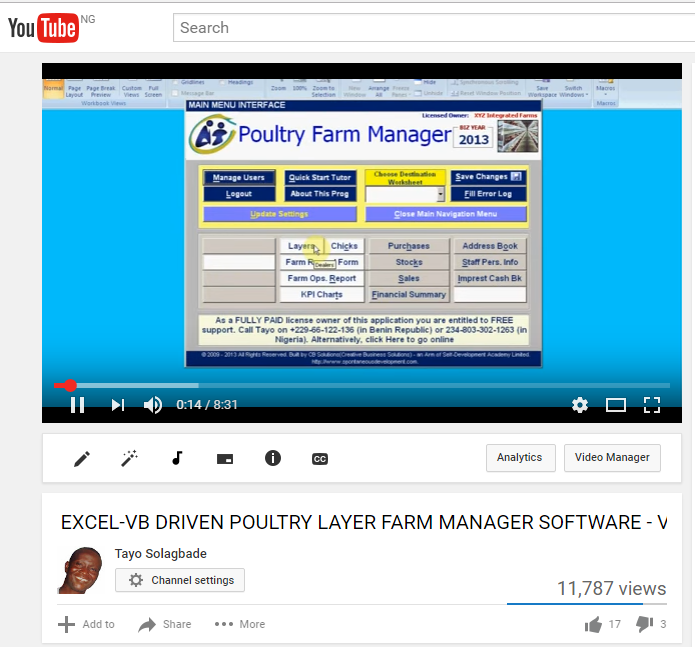
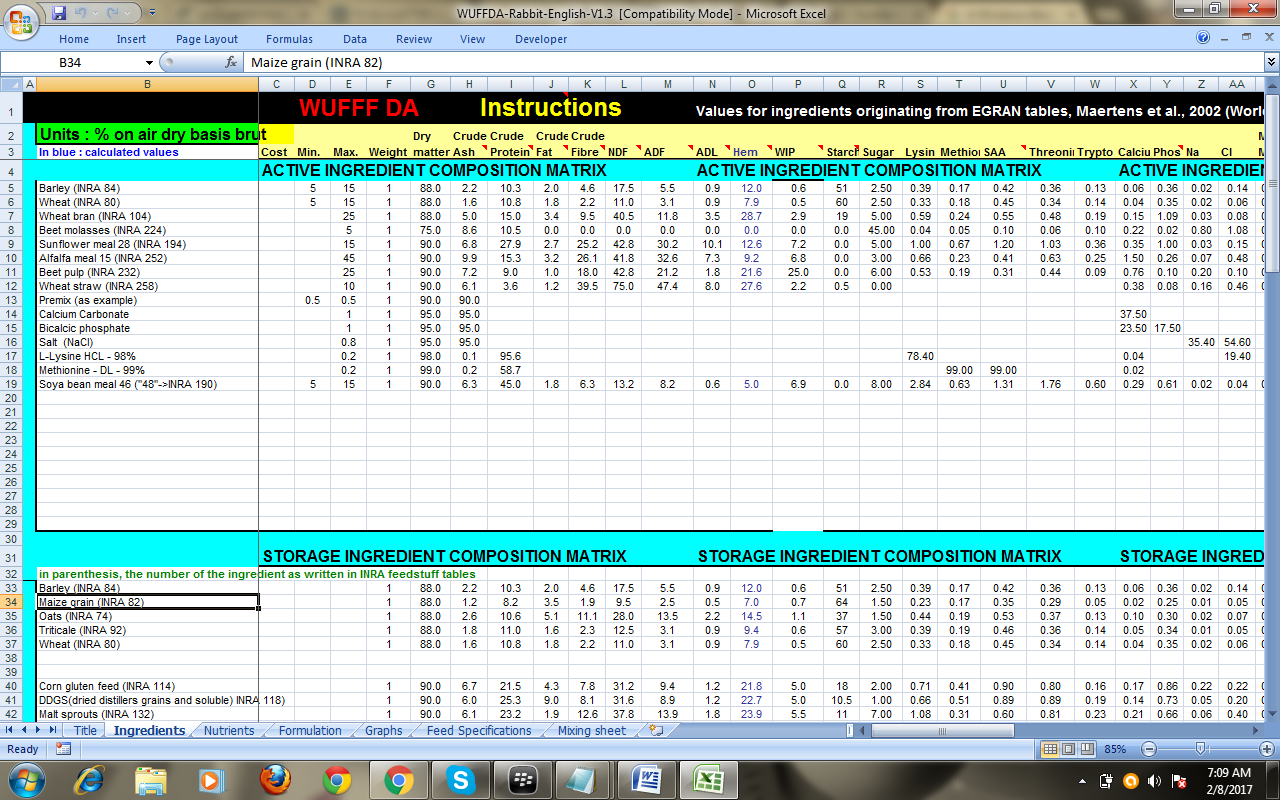


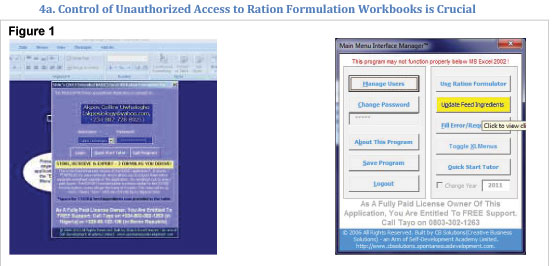
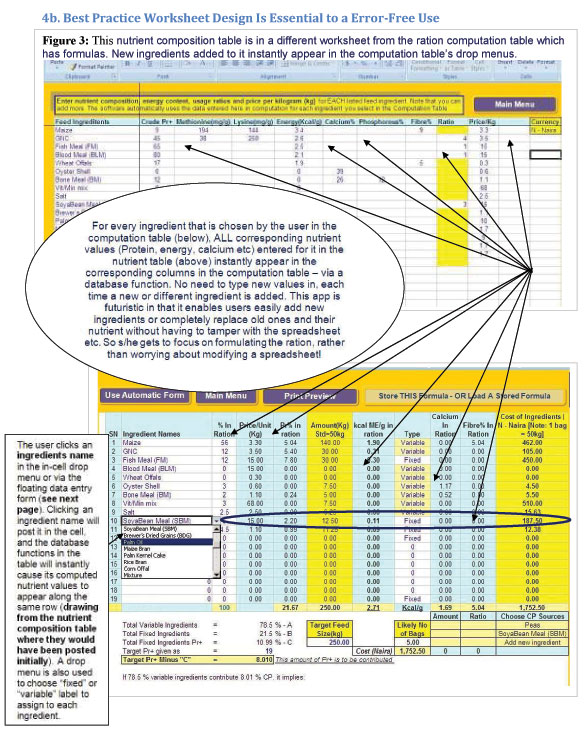
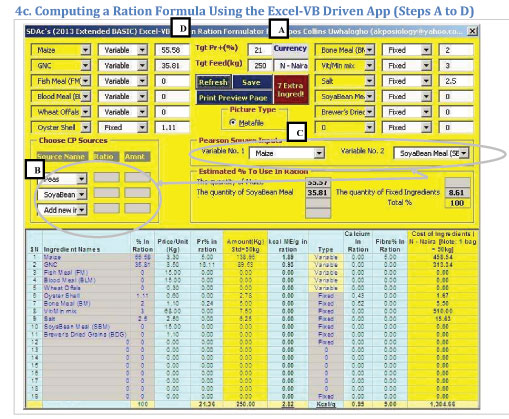
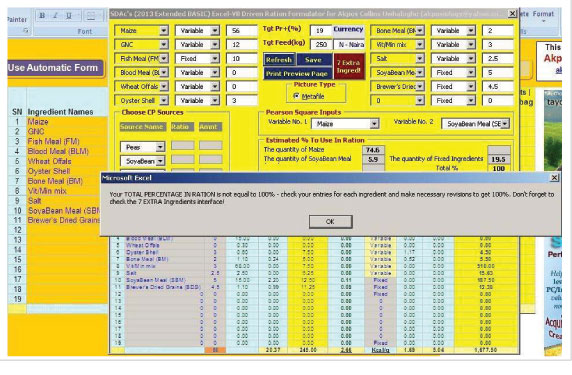
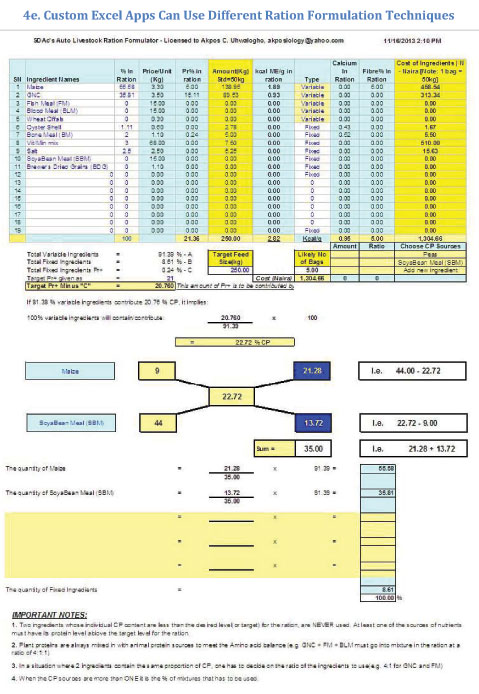
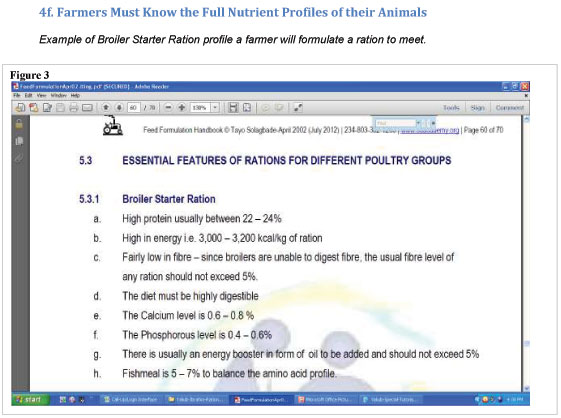
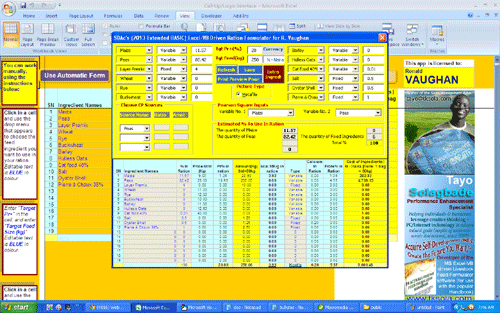
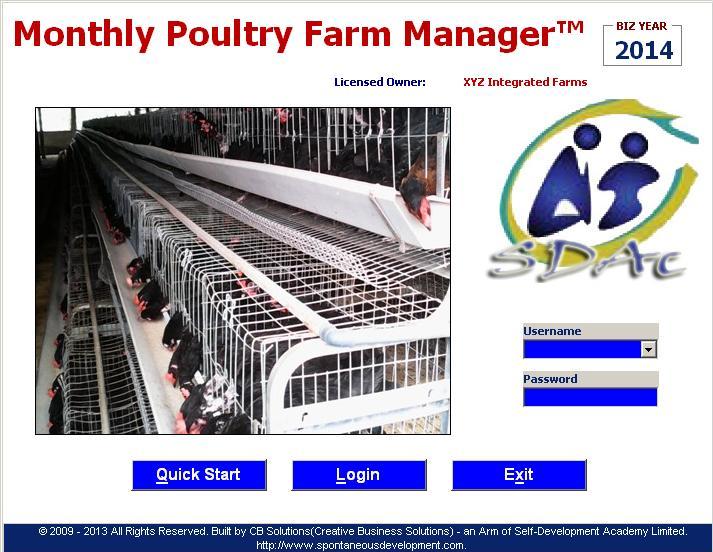

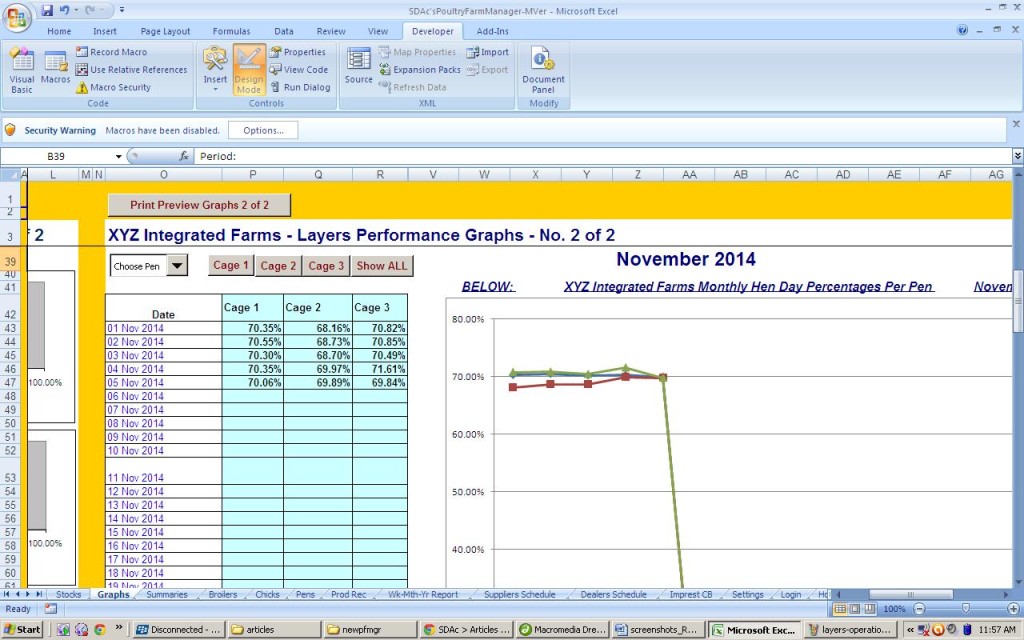
![Image: [Annotated] Cover of Agribusiness Research Paper I got paid to write in December 2013 by a European Union funded NGO based in Holland. It's titled 'Adoption of PC-Based Feed Formulation Methods by Farmers, Feed Manufacturers and Extension Professionals, in South West Nigeria.'](http://tayosolagbade.com/sdnuggets/wp-content/uploads/2015/08/AgribizPDF.png)